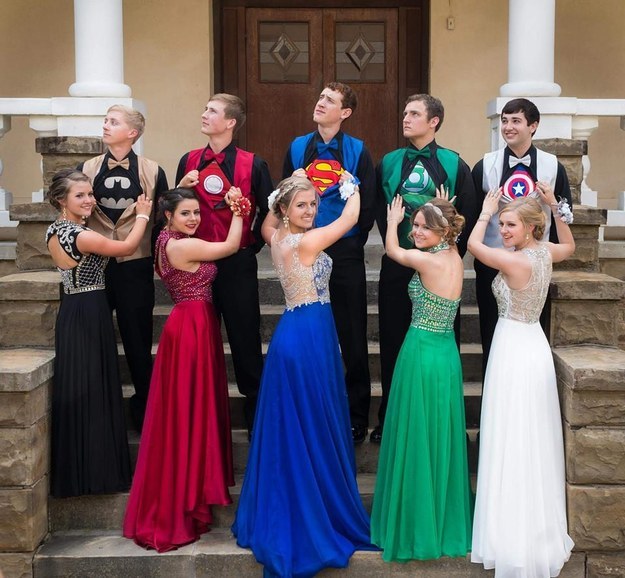Check out the picture below.
What do you notice? What patterns do you see?

Source: Buzzfeed
In the picture, a group of young adults stand in two rows on steps in front of a home. The students in the back appear to be young men and are wearing pants, shirts and vests. They are looking off into the distance, chins raised and hands on their hips. The students on the bottom step appear to be young women. They are wearing formal gowns that are color-coded to their partners in the top row. Each young woman is holding open their partner’s shirt to reveal a superhero logo (Batman, Iron Man, Superman, Green Lantern, Captain America – all male superheros) and looking over her shoulder back at the photographer.
Feel the need to look at more examples before making observations about patterns in the picture? Do a Google image search for “prom superheroes.”
What do you notice? What patterns do you see?
What we see, what catches our eye, is informed by who we are. Our lived experiences, our frustrations, our interests, background, family, and friends. The challenge with images like this, as it is with so many things, is there’s no right way to interpret it. There is, though, a responsibility to consider what message we’re sending when we boost pictures like this.
More to the point, and more to what inspired this post, is how we respond when someone says they see something different. What do I see? I see kids having fun at the prom. I also see an image that is just the latest in a long pattern that presents boys as heroes, girls as helpers.
A pattern that includes images like this:
Students deserve to play, imagine, innovate, and wear a cape! #edchat #colchat pic.twitter.com/N6j0HXlSud
— Steven Weber (@curriculumblog) March 8, 2016
Students deserve to wear a cape… like Wolverine’s, Spider-man’s, Batman’s, Superman’s, Captain America’s, or Iron Man’s, The Hulk’s (half of whom I don’t think actually wear capes…). There’s a pattern there. A pattern girls and boys notice and internalize, to say nothing of the messages transgender children may be picked up.
Boys are heroes. Girls can only be heroes if they stop being a girl. Just ask Mulan.
They’re just kids having fun at prom. They’re just examples of superheros. It’s not a big deal. It’s just a picture. It doesn’t have any social value beyond that.
Speaking of the non-importance of the images we see in the media, may I introduce you to Ms. Marvel? G. Willow Wilson, her creator, speaks to the importance of representation in comics.
Oh, in case you missed her, Marley Dias is changing the world. She’s changing it because she’s tired of “reading about white boys and their dogs.”
And by the way, did you catch #WhiteWashedOut yesterday? Give it a scroll. Read the words and stories of Asian Americans who talk about what it means to not see yourself represented in the media. I was especially struck by the stories of Asian American women around messages related to gender and beauty they got as girls.
One more: check out Geena Davis on Bullseye and listen to her talk about gender representation in the media. The statistics are staggering.
Representation matters. Patterns add up. If the images we boost, over and over again because they’re just “kids having a good time”, what images, voices, and representation are we not boosting? If we speak up about patterns and signal boosting and the response is, “eh, it’s just a picture”, what message are we sending about who gets to have their stories told or faces that look like them in pictures and media?
And for what it’s worth, there are about four things in the world for which I will not “agree to disagree.” This is one of them. I’ll go into the conversation with an open mind but any response that ignores the lived experiences of those who speak up about representation, I’m going to have words. Happy to hear your thoughts, though.





